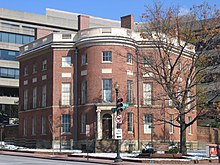American Institute of Architects
The American Institute of Architects (AIA) is a professional organization for architects in the United States. Organized in 1857, the Institute conducts various activities and programs to support the profession and enhance its public image, including periodically awarding the AIA Gold Medal and the Architecture Firm Award.
Historical background

In the 1800s, anyone (masons, carpenters, bricklayers, etc.) could claim to be an architect; no schools of architecture or architectural licensing laws existed.
On February 23, 1857, a group of 13 architects in New York City (Richard Upjohn, H. W. Cleaveland, Henry Dudley, Leopold Eidlitz, Edward Gardiner, Richard Morris Hunt, J. Wrey Mould, Fred A. Peterson, J. M. Priest, John Welch, Joseph C. Wells, and Charles Babcock) met to form the organization (originally New York Society of Architects) with Richard Upjohn as its first president.
The mission statement was modified in 1867:
"The objects of this Institute are to unite in fellowship the Architects of this continent, and to combine their efforts so as to promote the artistic, scientific, and practical efficiency of the profession."
The short-lived Western Association of Architects (WAA) in Chicago, which championed licensure for architects, merged with the AIA in 1889.
In 1898, the Institute moved to Washington D.C. where a large number of public building projects were being commissioned by the federal government, to be paid for with funds controlled by Congress. The AIA was headquartered in the Octagon, a historic house built in 1799, and Glenn Brown became executive secretary.
The U.S. Commission of Fine Arts was established in 1910.
Membership
The AIA membership has grown to over 80,000 with more than 300 state and local chapters, called components, in the U.S., UK, Europe, and Hong Kong.
membership classifications:
- AIA (architects--by law, only those with professional licenses may be titled "architects")
- Associate--designated as Assoc. AIA--(licensure candidates; those with degrees in architecture; those working in a learning capacity under the supervision of an architect; or architectural faculty)
- International Associate--designated as Int'l Assoc. AIA--(those licensed as architects internationally but not legally allowed to practice architecture in the United States)
- FAIA (Fellows of the AIA)
- Emeritus --designated as AIA-E--(retired licensed architects)
- Allied Member (marketing professionals, engineers, photographers, contractors, landscape architects, etc. Those folks who work in affiliated industries to architects. At some local chapters this category is termed "Affiliate Member.")
- Student--Not a National AIA membership; most students are "local chapter only" members.
Allied and student members may choose to be members only at their local chapters; allied members can also choose National-only membership. All other membership categories are required to pay dues to their local, state and National chapter.
Louise Bethune was the first woman member.
Honors and awards
Awards for architects licensed in the United States
Honors Program:
- Gold Medal
- Architecture Firm Award
- AIA/ACSA Topaz Medallion for Architectural Education
Institute Honors:
- Honor Awards for Architecture - new and restoration projects anywhere in the world
- Architecture
- Interior Architecture
- Regional and Urban Design
- Twenty-five Year Award
This award, recognizing architectural design of enduring significance, is conferred on a project that has stood the test of time for 25 to 35 years. The project must have been designed by an architect licensed in the United States at the time of the project's completion. AIA members, AIA components, and Knowledge Communities are urged to submit projects completed between 1972 and 1982 that have contributed meaningfully to American life and architecture.[1]
Achievement:
- Young Architects Award
- Edward C. Kemper Award
- Thomas Jefferson Awards
- Whitney M. Young Jr. Award
CoSponsored:
- AIA/HUD Secretary's Housing and Community Design Awards
- AIA/ALA Biennial Library Building Awards
- AIA/Housing Committee Awards
Membership Honors
- Fellowship
- Honorary Fellowship
- Honorary Membership
Opinion Surveys
The institute released an opinion poll in 2007 of the favorite pieces of American architecture, resulting in a list of 150 buildings around the nation. The top favorites were:[2]
- Empire State Building
- The White House
- Washington National Cathedral
- Thomas Jefferson Memorial
- Golden Gate Bridge
See also
- American Architectural Foundation (AAF)
- American Institute of Architecture Students (AIAS)
- Association of Collegiate Schools for Architecture (ACSA)
- National Architectural Accrediting Board (NAAB)
- National Council of Architectural Registration Boards (NCARB)
- Architectural Record - official magazine of the AIA
- eOCULUS - bimonthly e-zine of the AIA New York Chapter
- Local Chapters of the AIA
Notes
- ^ Twenty-five Year Award on the AIA website
- ^ "In the Eye Of the Beholder" Wall Street Journal Feb 7, 2007 B1
External links
- American Institute of Architects - official website
- Local Chapters of the AIA
- Honors and Awards
- AIA 150 flickr group
- [1] AIP Pennsylvania FAIA
